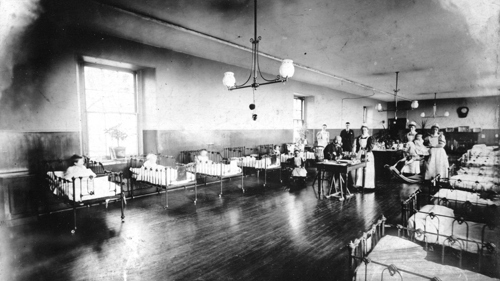Barnhill Poorhouse - Times Past

In partnership with the Glasgow Times, our archivists are exploring Glasgow's fascinating history. This week, Irene O'Brien writes about Scotland's largest poorhouse - Barnhill.
Barony Parish Poor House at Barnhill was opened in 1853 and an adjoining purpose-built hospital was added in 1880. In 1898 the Parish Council was amalgamated with the City Parish, and the poorhouse and the hospital were named Barnhill. By 1905 it was Glasgow’s only poor house and Scotland’s largest, with 2,000 inmates.
Poor houses were established by an Act of 1845 which introduced Parochial Boards of management across Scotland to administer poor relief. This was in the form of indoor relief in a poor house or outdoor relief. Relief in Scotland was primarily outdoor, which would be small sum of money, or benefits in kind. This was designed to be partial help, subsidy to support of charity or benefit society, most of all family help. On no account should paupers be better off on the poor roll.
Initially indoor relief was reserved for destitute persons, incapacitated by youth, old age, disease (mental or physical) and friendlessness, i.e., they had no one to look after them. By the early 1850s, the poor law authorities began to use the poor house as a ‘test’ and benefits became discriminatory. In the 1850s a new class of pauper was established which was for fraudulent claimants, ‘all persons of idle, immoral or dissipated habits, who if admitted to outdoor relief, would squander their allowances in debauchery, or otherwise misapply them'.
By the 1870s, women with illegitimate children, or widows with children who might be at risk were only allowed indoor relief in the poor house. Increasingly the poor house was seen as a test and the rules and regulations were designed to make it more irksome than labour 'without such discipline and restraint, to those who are not truly fit objects of parochial relief’.
Barnhill was extended in 1904, which accommodated the ‘test house’ where applicants were tested for their suitability for relief. They were set to work at some onerous or monotonous task to establish they were deserving poor, in desperate need of poor relief assistance, and not malingerers or other undeserving cases. If they refused to work or proved "difficult", they might be shut up in a special single punishment cell.
Barnhill had a terrible reputation for the harsh conditions in which the inmates were forced to live and work. To help remove the stigma attached to the institutions, both poor house and hospital were renamed Foresthall in 1945.
